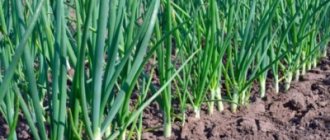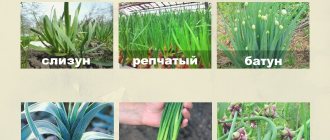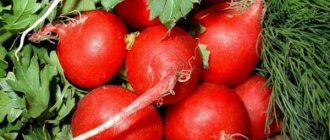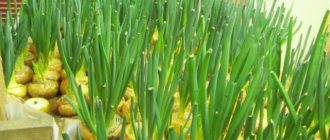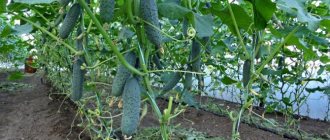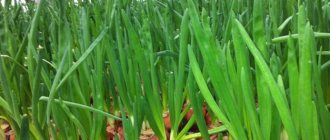It should immediately be noted that this technology has gained high popularity in recent years. Prices for greens are constantly rising. The main thing is to think through all the details.
But there are also disadvantages to this business. Occupying greenhouse production facilities with parsley is now considered outdated - the yield is low (2-3 kg/m2), and does not fit into modern hydroponic technologies (on mineral wool tiles), and there is not enough light, and there is a lot of manual labor, and the collected greens quickly deteriorate (short-term storage products). There is also a problem with storing root vegetables. Doing this in the basement in boxes is an outdated method, and storage units with computer-controlled climate control are even better. Gradually, greenhouse plants began to abandon this crop, and only recently has it returned. Let's look at each step of this technology.
What should a winter greenhouse be like?
For year-round use, you need an insulated permanent greenhouse, which is located on a small hill or located on a flat area. The building must be protected from northern winds, for which the wall on the windy side can be:
- make deaf;
- equip with an insulated vestibule.
A good option would be an extension to a utility building or residential premises. A winter greenhouse must be installed on a foundation buried 0.8 m. Such a building must be protected from flooding by precipitation, melt and groundwater. In winter, the heating system must operate without failure, since the slightest deviation in microclimate conditions will cause the death of plants.
In addition, the greenhouse must be equipped with an irrigation system, ideally a drip irrigation system (to save water), as well as a ventilation system. If in summer and spring plants can carry out the process of photosynthesis without additional lighting, then in winter this will be impossible. In this regard, you need to take care of organizing additional lighting.
The best option is infrared lamps. The greenhouse must be equipped with thermometers in order to be able to control the temperature. Even in the most severe frost, the minimum permissible value is +15°C. Optimally, the room temperature should be maintained within +20…+23°C.
Sales, sales
When onions are produced in large quantities, they are grown year-round.
In summer they are planted in the field, and in winter - in heated greenhouses.
Greens are a perishable product; after cutting, they must be sold within a short period of time.
Most are sold through wholesalers who sell vegetables, or under agreements with retail chains - shops, cafes, restaurants, kebab shops and with herbs traders at the market and in vegetable stalls.
You should start with a small volume in the fall, study the demand, and create your own customer base.
Features of growing parsley in a greenhouse in winter
Forcing parsley in a greenhouse in winter is not an easy task. There is difficulty not only in the growing process, but also in organizing the sale of cut greens. But such a business also has many advantages.
Advantages
Greens are good for health, and consuming them in winter allows a person not to get sick and maintains a vitamin boost. Parsley is in demand all year round, so the main advantage of growing this crop in a greenhouse is the ability to harvest all year round, not only for personal use, but also for sale.
Other advantages:
- low incidence and resistance to pests;
- greens are easy to care for;
- the germination period is short, profit can be made quickly;
- the cost of fresh greens in winter is much higher than the funds spent on purchasing seeds and care;
- in the southern regions, greens are grown even in an unheated greenhouse.
Flaws
Where troubles might lie:
- Cut parsley begins to lose vitamins after 2 hours, and after 3-4 hours it withers outdoors or indoors. You need to store greens in a bag or container in the refrigerator or urgently look for a place to sell.
- If the greenhouse is located in an area with a harsh climate, it will have to be heated in order to harvest crops from autumn to spring. The price of heating appliances and electricity charges will be very significant.
- The business of selling greens is developed throughout the country. Store shelves are filled with different varieties of parsley all year round. In some regions it is difficult to enter the product market with this production; you need to look for regular customers.
Has anyone planted a mini garden with greenery on a window?
Lyudmila Venediktova
On the south window we grew: basil - it grows very well, loves warmth, does not like drafts, you can cut it many times - it becomes even more magnificent, watercress, celery and parsley - grow (from seeds), but worse than basil, dill and radishes - they don’t like the windowsill, I’ve tried it many times - separate dead specimens of mint grow - it grew well, then I transplanted it into the garden, garlic from cloves, onions - they grow together, you need to place them close to each other in some shallow container, you can even without soil - so that only water is at the bottom, tomatoes (special low-growing varieties) - grow and bear fruit, but more for the soul than for food. You can also grow cucumbers on the windowsill, but they quickly begin to get sick, give a couple of cucumbers and “die” safely. pepper (any kind, including hot) - grows well and bears fruit on the window. For the second year now, we have had hot peppers of the “All the Sky in the Stars” variety growing in our window. Good luck to you, good harvest and good mood!
Alexander Pankov
I planted everything, but the Odessa curlytail is something, a thistle or something, plant what’s easier and that’s it
Lexa (Rulimon)
planted a blade of grass for the birds from the bird's death
Elena WWW
the best watercress
Tatyana Kalinina
I have basil, parsley and celery constantly growing in winter, dill does not grow, and also sage and thyme. All this grows in one box and gets along quietly. next to them are fragrant onions.
Zhenechka =)
I plant cressalate all the time. I love it very much:) it grows instantly:) my son planted dill (seeds from a plant), it took a long time to grow, he is picky. Parsley grows well. marjoram - I don't know. I also plant chives. In general, if there is fertile soil, good lighting by the sun (or fluorescent lamps), and watering, then there will be no difficulties or pitfalls with greenery on the window :)
Kisunya)
https://sale-40.ru/?id_tov=110318-112417-2193201&partner=brtv-z
https://sezzzon.ru/product_print.php?item_id=481
https://www.top-shop.ru/product/19664-ves-v-gh201/
TULEPASHA
The dill has been “sitting” for about a month. It’s branchy and green, but once it has grown to 10 cm, it sits there. The arugula sprouted very poorly and disappeared, the “family” onion is great, we’re already finishing it, the indoor tomato bears fruit and blooms. Sown in November, it stretched out and produced only a couple of tomatoes.
Lyubov Kuznetsova
need lighting.
Features of the parsley business
When drawing up a business plan for growing parsley, it is necessary to take into account that the costs will be recouped and will become profitable if a number of conditions are met:
- summer area for parsley is at least one hundred square meters;
- a place for selling fresh herbs has been prepared in advance;
- the greenhouse was built in a winter design with heating and lighting;
- an area in the apartment with the necessary equipment has been allocated;
- seed material produced in-house or purchased in bulk;
- There is a specialist in growing vegetables.
A stable supply of green mass can be ensured only with knowledge of plant agricultural technology. In mass growing of greens, the leaves must be healthy and attractive to buyers before cutting. Parsley must be supplied fresh for sale. It can be stored in a cool place for no more than a week, losing its aroma. In order to make a big profit, you need to achieve a high speed of growing parsley in a greenhouse.
The business will be more efficient if, at the same time as parsley, you are engaged in forcing onions, growing early ripening lettuce and dill. Complex deliveries in distribution centers are more valuable.
Volumes and income
First you need to understand that several kilograms of parsley grown on your own plot and sold on the market will not bring much profit.
advantages:
- has good profitability (in autumn, the wholesale price for onions is about 8-10 rubles and below (check in your region), and the price for green onions is at least 100 rubles per kg),
- low costs: planting material, heating, packaging, delivery,
- small initial capital,
- care does not require much labor, the plant is unpretentious,
- quick turnover of funds from one plot during the autumn - winter season when choosing fast-ripening varieties.
Like any business, this one has its pitfalls and subtleties. This article presents video material and books on the topic under consideration that can help a novice entrepreneur.
Which varieties are suitable for growing in a greenhouse in winter?
Root and leaf varieties of parsley are grown in the greenhouse. Root, with thick and strong roots similar to carrots, is used for pickling, in soups and sauces.
Its greens are also eaten, but they feel a bit rough. For leafy varieties, only the leaves are consumed, the roots are not eaten.
When choosing a parsley variety, consider:
- Is the variety suitable for your climate?
- is it suitable for greenhouse cultivation;
- whether the variety is resistant to diseases that develop in greenhouse conditions;
- yield per unit area.
Leaf varieties
They can be curly or smooth, the height reaches 60 cm.
Leaf varieties that grow well in a greenhouse in winter:
- Mooskrause is early ripening, consumed fresh and dried, the variety has an aesthetic appearance;
- Breeze is mid-season, after cutting it remains fresh for up to four hours, greens are consumed 2.5 months after sowing;
- Bravo - mid-season, productive, has a strong pleasant smell, the leaves are arranged vertically, after cutting it does not wither or lose its presentation for up to four hours;
- Esmeralda (photo on the right) - mid-season, the average weight of one bush is 50 g, 30 leaves per rosette, after cutting new greenery quickly grows;
- Bogatyr is an early ripening plant, the rosette is semi-spreading, the greens have a spicy aroma and an aesthetic presentation, after cutting the greens quickly grow back.
Root parsley
The most famous varieties of root parsley:
- Bordovikskaya is a productive late variety, root weight is up to 150 g, can be stored in the cellar for a long time;
- Urozhaynaya - an early ripening variety, a white root crop, got its name for its high yield - 3-6.5 kg per m²;
- Root Berlinskaya - an early ripening variety, light yellow root, aromatic and pleasant to the taste;
- Piquant - a mid-season variety, the greens have a pleasant taste and aroma, the weight of the root crop is up to 110 g, the yield is up to 2.8 kg per m², it is stored well;
- Final is a mid-season variety, root weight is up to 190 g, yield is up to 2.5 kg per m², shelf life is average, so it needs to be sold quickly.
How to choose varieties and when to start sowing
You can start sowing as early as January or March, if all conditions and suitable temperature are created in the greenhouse. The required temperature is 12-20 degrees. If it rises higher, the greens will wilt. Optimal air humidity is 75%. Purchasing parsley seeds for an area of 100 square meters will cost around five hundred rubles.
When choosing the right varieties of parsley, be guided by market demand. The most popular varieties are leafy ones, but root vegetables are less popular, so for growing parsley on a business scale it is better not to waste time on root varieties, although this niche is less occupied.
Remember that no matter how high-quality the seeds are, the germination percentage usually does not exceed 70%, so it is better to sow more and then remove weak seedlings. The first shoots will appear in approximately two weeks, and the first harvest can be harvested 2-2 and a half months after germination.
Since we are focusing on continuous harvesting, we need to plant parsley every two to three weeks, then it will have different ripeness periods, and you will have to harvest it almost every month.
After how many days do dill and non-root parsley sprout?
Gena Abonos
Parsley is a slow-growing crop. Be sure to soak it for at least a few hours. Then it will sprout in 10 days. And dill sprouts on its own in spring and autumn after rain. The timing is very dependent on temperature and moisture.
Nadezhda Kotsareva
10-21 or do not germinate at all
Eugene
in 15 days.
Lyuba Ustimenko
Dill may not sprout due to increased acidity of the soil, if you do not sow it yourself every year, add wood ash to sowing dill at the rate of 1 bucket per 1 square meter. Soak the parsley in water at 35-40 C for a day, dry it and sow. It is necessary to cover with film or covering material until germination - from 10 to 30 days
Alexei
Dill, leaf parsley, chervil, fenugreek, coriander and garlic grow like weeds in our garden. Or they can be sown themselves from completely unharvested greenery. Or, like with garlic, we scatter ripened “bumps” from garlic shoots that were not picked off in time to pickle them throughout the garden and raspberry fields.
Natalia Zotova
parsley sprouts without pre-soaking in 7-14 days, and the soil should not dry out!
Elena Orlova
if parsley sprouts from purchased seeds in 14-21 days, and dill in 5-10 days
Olga Plyusnina
Parsley is a slow-germinating seed... the germination rate is up to 40 days! Personal experience proven over the years - before sowing, pour the seeds into your palms and rub them very hard, they will not break, but scratch each other, as a result of which microcracks form on the skin of the seed, then soak in MILK, preferably cow's, for 2 hours, then a little dry and sow... They sprout together on the 7-8th day. Be sure to apply basic fertilizer with a high nitrogen content before planting, but strictly according to the application rate; during the growth process, it is good to shed with water with the addition of 1 tablespoon of azofoska per 10 liters of water,
Preparing soil in a greenhouse
Before growing parsley, prepare the soil. The crop yield per 1 square meter largely depends on this. meters. It is more convenient to prepare the soil in the spring for sowing seeds in the fall. If parsley is planted before winter, then all preparatory work is completed a month before sowing the seeds. At this time, useful fertilizers are applied simultaneously with digging.
Features of planting and growing
Parsley in a greenhouse has a rich color, natural aroma, and is well stored during transportation if comprehensive and consistent care is provided for it.
Seed preparation
First, the seeds are sorted: they are soaked in water for 3 hours, and empty specimens that float are thrown away.
Then they are germinated: placed in a damp cloth folded in several layers, left for 4-5 days at room temperature - for example, on a saucer. As soon as the fabric dries, it is moistened - and so on until sprouts appear. The last stage is hardening. Sprouted seeds are placed in the refrigerator for 10 days. The temperature in the refrigerator should be 1-2°C.
Not only seeds are planted, but also root crops. To do this, they are kept in sand at a temperature of 2°C for 24 hours. The greenery is cut off from them within a month, when its height is 25 cm.
Reference. Parsley contains a lot of essential oils, which give it a strong aroma. But they also prevent the seeds from germinating quickly in the ground, so the germination stage at home is mandatory.
Soil preparation
Parsley is unpretentious to the composition of the soil, but prefers moderately fertilized soils, sod-podzolic or light loamy type. Before planting, mix garden soil with peat, then spill it with a solution of copper sulfate, which destroys pest larvae and pathogens in the soil. Then complex mineral compounds and wood ash are added. After this, the ground is loosened.
Important! Parsley does not grow well in heavy soil, such as loamy soil. The root crop always has gnarled, ugly shapes, and the greens are thin and stunted.
Planting scheme and technology
Cut grooves at a distance of 15-20 cm from each other with a depth of 2-3 cm. Seeds are placed in them at a distance of 3-5 cm from each other, sprinkled with earth, compacted and watered abundantly with settled water. If there are more seeds than expected, they are sown more densely and thinned out after germination.
Root crops are planted in furrows at an angle of 45° at a distance of 10 cm from each other, sprinkled with soil so that the neck is visible above the surface, compacted and watered generously.
Important! To prevent diseases and pests from damaging parsley in the greenhouse in winter, do not plant it in place of legumes, cabbage, onions or tomatoes.
Features of care and feeding
The main factor in the germination of greenery and its presentation is the temperature, which should not fall below 10°C.
The soil is moistened using a watering can. It’s easy to understand that it’s time to water the crop: take the top layer of soil in your fist; if the soil crumbles or becomes dusty, it’s time to water. While the soil is moist, remove weeds.
Attention! Jet watering is not used for parsley so as not to wash the seeds out of the soil.
If organic fertilizers were used in preparation for planting, then complex mineral fertilizers are used during cultivation. Leaf varieties are fed with saltpeter twice during the growing season: 50-60 g of fertilizer per m². Phosphorus-potassium fertilizers are applied to root varieties.
For full growth and development, parsley requires a constant influx of sunlight. In winter it is not enough, so artificial lighting with fluorescent lamps is organized in the greenhouse.
How to grow a rich harvest
How to grow parsley in a greenhouse in winter and get large volumes? The secret is which greenhouse to use.
For parsley you need a greenhouse made of metal or wood, covered with polycarbonate. Such greenhouses do not require frequent repairs; they retain heat well and diffuse sunlight. Polycarbonate is lighter and stronger than glass.
In areas with cold climates, double glazing is used. It creates the effect of a thermos and retains heat twice as much as a single cover. The greenhouse must have windows for ventilation.
Beginning gardeners grow greens in the ground. After promoting the business, when the demand for the product increases, they move on to growing parsley on shelves. On the upper tier of the rack, plants are planted in boxes with nutrient soil or a hydroponics system is used.
Reference. Hydroponics is a method of growing greenery in artificial environments, without soil. Plants get all the nutrients they need from the nutrient solution that surrounds their roots.
Special containers for hydroponics are not required; parsley is planted in plastic cups. This technology saves the area of use of the greenhouse.
Causes of poor seed germination
Even experienced gardeners are not immune from such a problem as poor germination. This happens for several reasons:
- High acidity of the soil. The solution to this problem is to add limestone, chalk and ash.
- The soil is too dense. In such soil, it is difficult for weak shoots to break through, so lighten the soil by adding sand, sawdust, humus, and peat when digging.
- Little sunlight. In shady beds, parsley grows poorly, the plant lags behind in growth, weak, light in color. The aroma and taste are practically absent.
- Expired seed expiration date. Material up to 3 years of storage is suitable for sowing. If it takes longer, there may be no germination at all.
- Preservation of the shell of essential oils on the surface of the seed. In the absence of a sufficient amount of moisture, this layer is not washed off and the seedlings are postponed.
By adhering to all the rules for preparing seeds and soil for sowing parsley, carrying out timely agrotechnical measures and preventive measures to combat diseases and pests, obtaining a rich harvest of greenery is guaranteed. Parsley will delight you with its beautiful appearance, pleasant aroma and nutritional qualities all year round.
0
0
Copy link
The nuances of growing for sale
Growing parsley for sale in winter is a profitable business. The main requirements: you need to grow greens in large quantities, and choose varieties that have an attractive presentation.
The germination rate of seeds, even if all preparation and planting conditions are met, is 70%, so they plant thicker and then thin out weak seedlings. Parsley is not picky about the soil; it is planted in soil prepared with organic matter and then fertilized with mineral compounds.
Transport parsley carefully so as not to crush it, otherwise it will lose its presentation. If delivery to a store or market takes less than four hours, the parsley is cut off. If it is transported longer, it is watered abundantly and after 3-4 hours it is pulled out by the roots (leaf varieties). Then they are placed in a plastic container in a special solution: one aspirin tablet is diluted in 1 liter of water. The container is placed tightly, for example, in a box, and hermetically sealed.
Features of the parsley growing business
The demand for goods is spring and autumn: it is during this period that large volumes need to be provided. To create a business growing greens, a business plan is drawn up. The first point is counting funds.
What expenses need to be calculated:
- soil and greenhouse;
- heaters and phytolamps;
- hydroponics racks;
- thermometer and rain watering system;
- seedlings and seeds;
- repair costs;
- advertising;
- payment for freight transportation.
Parsley sprouts and grows up to 80 days, and it must be sold 3-4 hours after cutting so that it retains its beneficial properties and does not lose its presentation.
There are 3 sales strategies:
- Retail. Independent sale of products on the market. It takes a lot of effort and time. Profits are low due to low volume.
- Sales to resellers who distribute products. Minus - resellers buy greens at the minimum price, the profit will again be low.
- Sales of products to stores, supermarkets, catering outlets. The most cost-effective way: they hand over all the grown products and immediately make a profit. Difficulty: need to find clients.4
How to calculate approximate profit
If the greenhouse is 300-400 m² in size, the harvest is from 1.7 kg per m², ripening within two months, then 1200 kg of greens will be harvested in two months. At a cost of 150 rubles. per kg monthly income will be 90,000 rubles. (for 2 months – 180,000 rubles). Costs will be up to 35% of this amount, net profit will be about 60,000 rubles. (or 120,000 rubles for 2 months).
Reference. In winter, prices for parsley double, which means your income will double.
Sales of goods
A profitable option would be to cooperate with snack bars and restaurants that constantly need fresh herbs, regardless of the season.
You can also look for companies that specialize in preparing all kinds of salads for sale; they also always need greens in large quantities.
You can also independently sell parsley on the market, naturally at higher prices, but this will take much more time. In this case, in the business of growing parsley, you may need a competent distributor.
Prospects and risks of green business
Although, in general, growing greens for sale is a promising and profitable direction, but only if several conditions are met. Production volumes come first - the larger they are, the better. And on the second (although this condition is no less important) is the availability of sales channels. You won’t earn much by selling greens on your own at the market or selling them to resellers for pennies. You can negotiate supplies with cafes and restaurants, but, firstly, their purchase volumes are not so large. Secondly, you need to provide all documents for your products. And thirdly, achieving such agreements will be very difficult.
How to care for greenhouse greens
For good formation of greenery in a greenhouse, you need to irrigate and fertilize the soil on time, and in addition, do not forget to remove the cheesecakes. Parsley is especially sensitive to the presence of weeds during early development.
It is better to remove weeds a day after good irrigation, combining the operation with synchronous loosening of the soil.
Watering the plant should be done constantly so that the soil does not dry out. However, you should not over-moisten the soil either. It should be borne in mind that the leafy type of greens is much more demanding than the root types. The operation must be scheduled for the morning at sunrise or in the evening.
Advice!
It is better to irrigate the soil with infused water and keep it warm from the heating of the sun's rays.
Depending on the variety of greens, there is a feeding order. Fertilize the leafy species twice a season with saltpeter at a dosage of about 55 g/m2 per 1 sq. m. Feed root greens in the spring with complex vitamins, as they require phosphorus and potassium. During germination of sprouts, fertilize with superphosphate (70 g/m) and potassium salt (50 g/m) per square meter.

